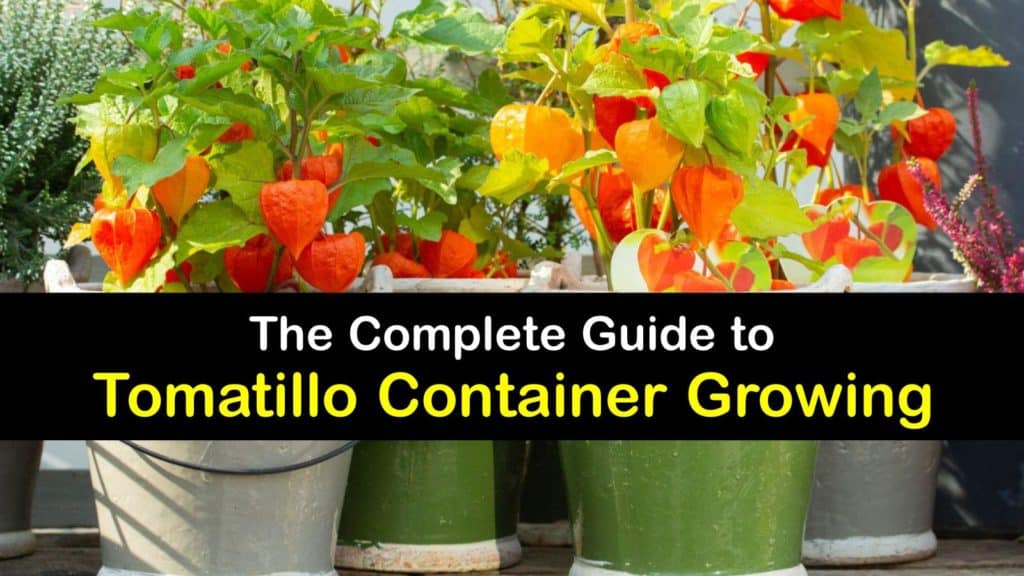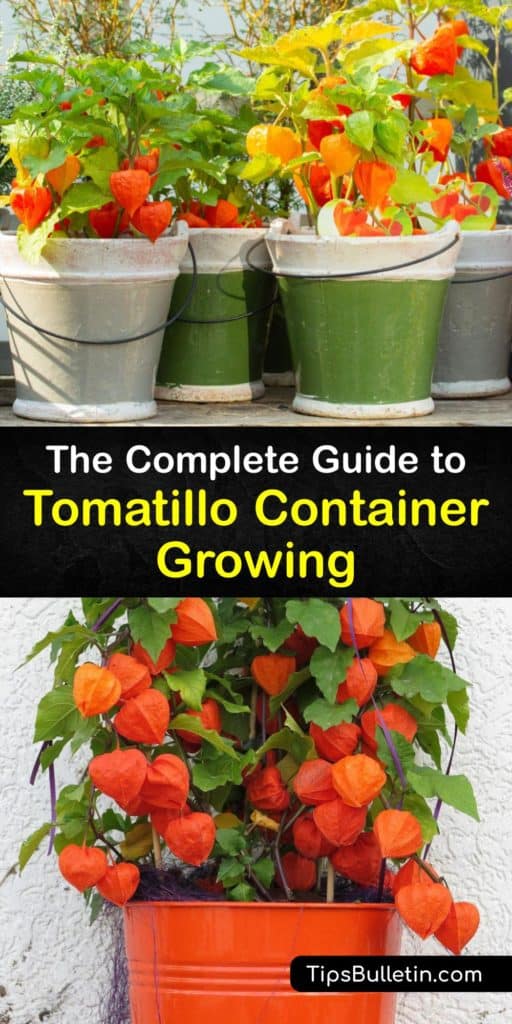What are tomatillos and what do tomatillo plants look like? Though tomatillos look like unripe green tomatoes, these plants are unique fruits that most people love. Unfortunately, not everybody has space to grow an entire vegetable garden. Learning how to grow tomatillos in a container is a perfect solution for any beginning gardener who wants to develop a couple of plants in a small space.
Growing tomatillos in containers is even more ideal because you have more control over the environment. Tomatillo plants are also called Physalis philadelphica and are members of the nightshade family.
Tomatillos are native to Mexico and Central America. People commonly use them in Mexican cuisine to make salsa verde and tart jams. Other common nicknames for it are toma verde and husk tomato.

The Benefits of Growing Tomatillos in Containers
Tomatillo fruits are also rich in vitamins and minerals, with tons of health benefits. While they may not technically be tomato plants, growing tomatillos in pots is the best way to start a container garden.
Learning how to grow tomatillos in containers is one of the simplest ways to get a container garden started. They are an outstanding crop for smaller areas or kitchen gardens. Whether tomato vs tomatillo, they require support from a stake or trellis, but the flowers attract many beneficial pollinators to increase fruit production.
Tomatillos are generally a green fruit and golf-ball sized or larger. However, there are yellow, orange, red, and purple cultivars that you may choose to grow instead. Some of the best heirloom varieties for growing tomatillos in a container garden include Purple Coban, Tomayo, Amarilla, and Rio Grande Verde.

How to Grow Tomatillos in a Container
Don’t jump the gun and start planting tomatillos in containers or follow the way to grow cherry tomatoes until you have all the tools necessary for success. Growing tomatillos and tomatoes starts with the proper soil type and containers.
The Perfect Soil for Growing Tomatillos in Pots
Tomatillo seeds require a rich potting soil that quickly drains. The same holds true for growing ground cherries in containers. Many gardeners choose soil enriched with organic matter – aged manure or organic mulch. These plants prefer to live in a neutral pH level between 6.5 and 7.0. Still, they tend to grow anywhere heat, sun, and regular water are provided.
Choosing a Container
Young plants can be deceiving if you have never seen these plants fully mature before. Mature plants are relatively large and sprawling. The best chance at success when planting tomattios and tomatoes in containers requires the largest container size possible.
Raised beds are also acceptable as long as they are deep enough. Larger pots can hold more potting soil and have better moisture retention overall. Any container that can hold a cubic foot of soil will do the trick. If you’re still unsure, a five-gallon bucket is a perfect size for individual tomatillo seedlings to grow in.
At least two tomatillo plants are necessary to bear fruit. Three or four plants are even better. To encourage pollination, place them next to one another because they are not self-pollinating.
Care Required while Growing Tomatillos in Containers
Part of figuring out how to grow tomatillos in a container is understanding the responsibilities required. Tomatillo plants need an area of full sun, so make sure to seek out a place where this need is met.
Support from a trellis is crucial if you don’t want them to sprawl over the ground and climb up other plants. A tomato cage works well if you don’t have a trellis. Remember that tomatillo plants might reach up to five feet tall and require enough space to spread out.
While tomatillos enjoy moisture, too much can cause root rot or blossom end rot. These problems are why six hours of direct sunlight and ample spacing and air circulation between plants are necessary.
How to Propagate Tomatillos
It is safe to start seeds about two months before the last frost expected in your growing zone. Tomatillo seeds germinate in four to seven days.
If you sowed them in smaller containers, start transplanting the seedlings to larger containers once their first set of true leaves forms. Only bring the plants outside to harden them off once the danger of frost is gone.
Planting Tomatillos in a Pot
If seeds are not available, transplanting tomatillos is also acceptable and should be done around the same time you plant your regular tomatoes. Fruiting will not happen if you do not have at least two plants in the same area.
Fertilizing your tomatillo plants is safe but might not be necessary if they are planted in nutrient-rich soil. If you feel that fertilizer is necessary, use one low in nitrogen and high in potassium and phosphorus.
Water your plants regularly to help with fruit production. One inch of water per week is perfect unless you live in dryer regions. Keep an eye out for common garden and veggie pests such as aphids and remove them as soon as possible to protect the plants.
Potted plants are not immune to disease either. Take care of brown spots on tomatoes and tomatillos to prevent plant and fruit damage.
How to Harvest Tomatillo Plants
It takes roughly 80 days until it is time to harvest tomatillos. Tomatillos are ready when the papery husk starts to break open. In some cases, the husks will not break, and you have to feel the fruits for firmness. Ripe tomatillos are usually green or pale yellow.
After harvesting the crops, remove the husks and wash the sticky residue off the fruits. Dry the green fruits and store them in a paper bag until ready to use them in a delicious recipe.
Heat your oven broiler and place a rack about four inches below the heat source. Set the tomatillos and jalapeno on a baking sheet and broil them until there are black spots on the fruits. Flip the tomatillos and pepper and broil for another four minutes.
Add the tomatillos, jalapeno, onion, cilantro, lime juice, and salt to a food processor and blend until you reach your desired consistency. Refrigerate the salsa for a few hours before serving. Put the salsa in freezer bags or containers for extended storage solutions and keep it frozen for about six months.
Tomatillos are more familiar when being served than in our garden beds. Growing tomatillos in pots doesn’t have to be a foreign concept any longer. All you need are a few common gardening supplies to produce the brightest and freshest green fruits in your area.

If this article explaining how to grow tomatillos in a container has helped you grow an unfamiliar crop to maturity, share this guide for growing tomatillos in containers on Facebook and Pinterest.